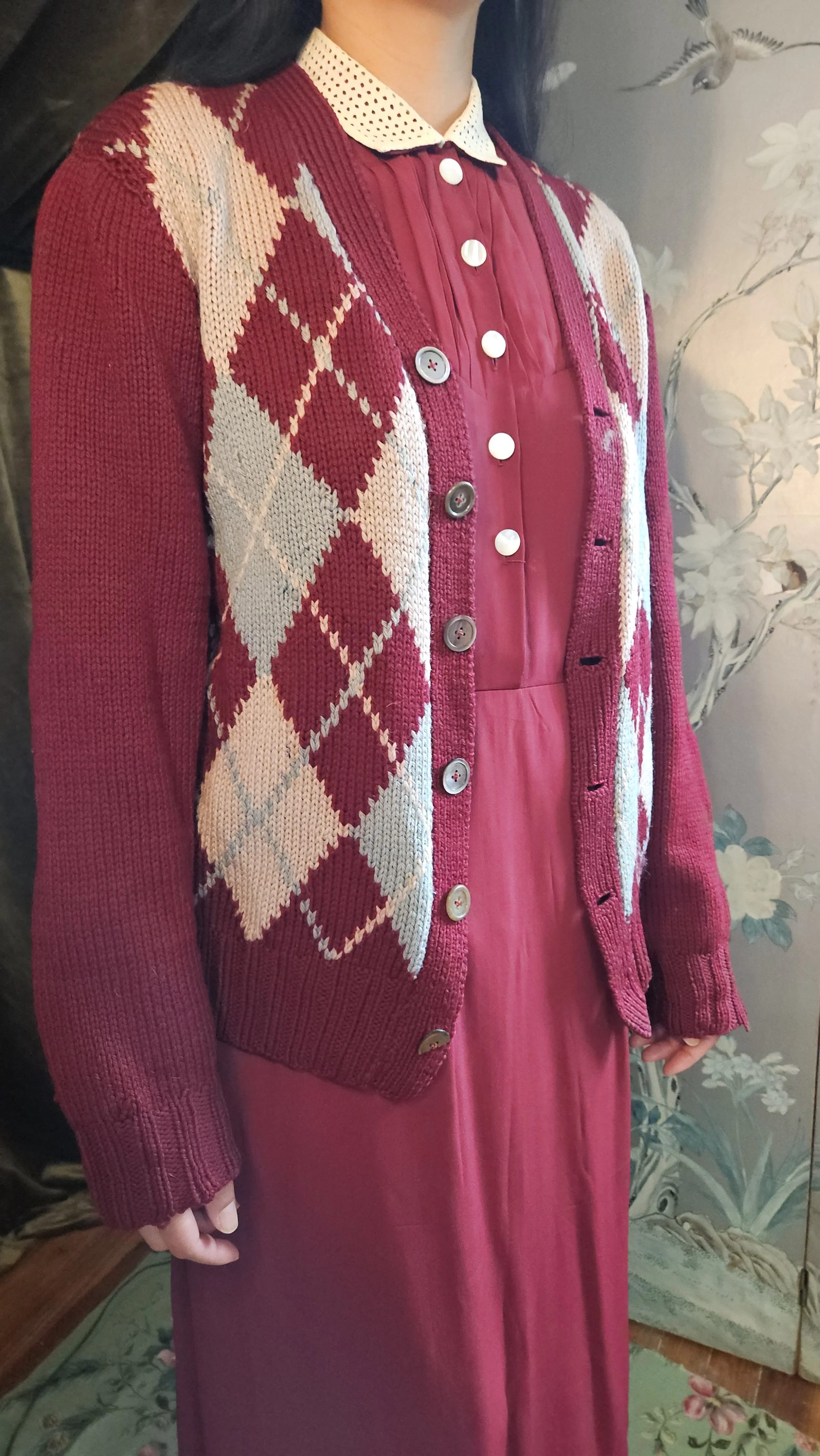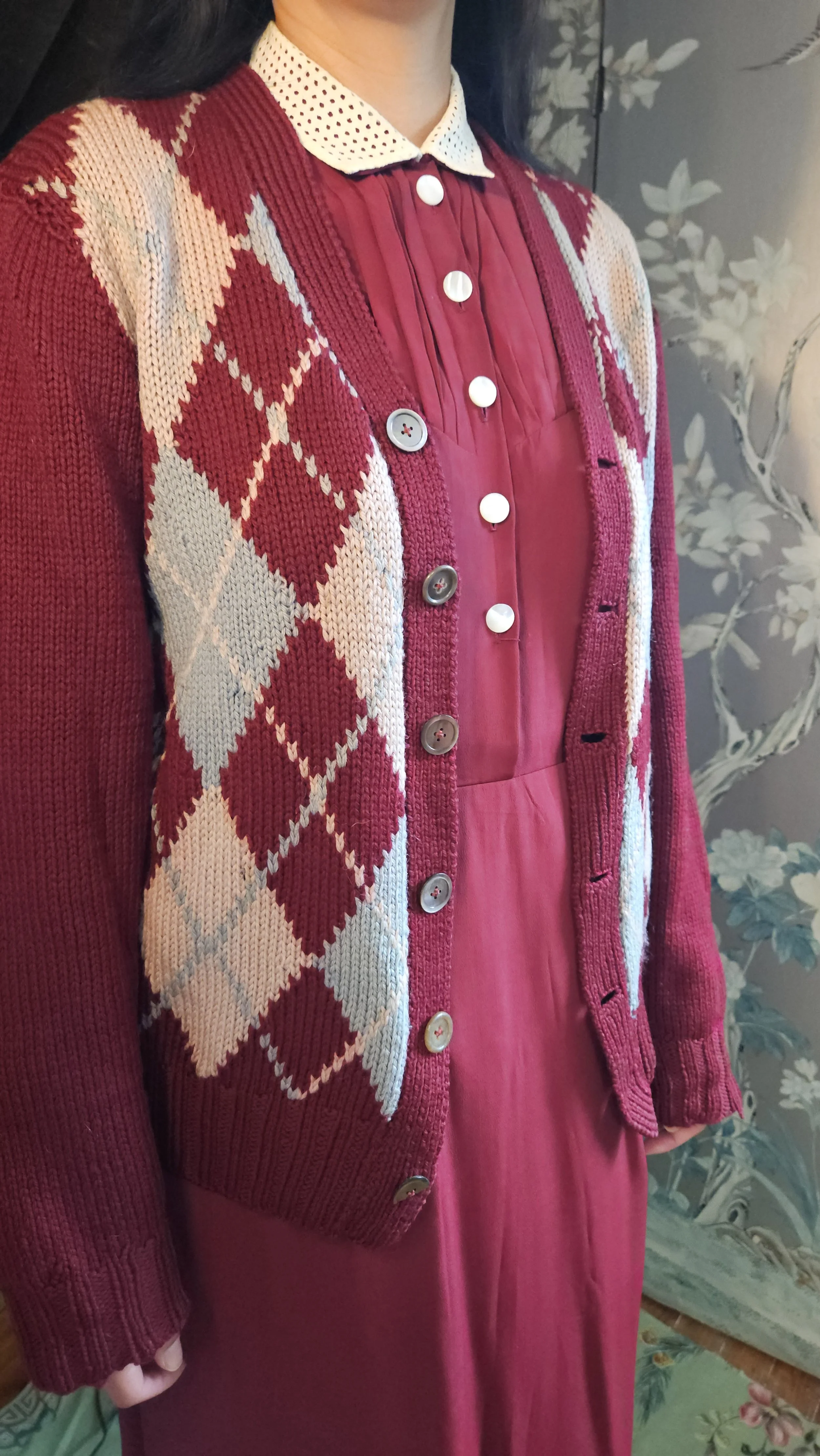 Image 1 of 3
Image 1 of 3

 Image 2 of 3
Image 2 of 3

 Image 3 of 3
Image 3 of 3




Hand-Knit Argyle Burgundy Sweater (c. 1930s-40s)
Step into the warmth and charm of the 1930s with this authentic vintage cardigan—a perfect blend of classic pre-war style and cozy craftsmanship. This piece features a bold argyle pattern in deep burgundy, soft cream, and pale blue hues, evoking the sporty elegance popular during the decade. Pair it with a simple dress or high-waisted trousers for an effortlessly nostalgic look that’s as wearable today as it was nearly a century ago.
Features:
Authentic 1930s vintage homemade construction and styling
Rich burgundy wool knit with contrasting argyle pattern
Classic front button closure with original vintage buttons
Thick ribbed cuffs and hem for a structured, cozy fit
Perfect layering piece for autumn or winter ensembles
Measurements:
Bust: 40 inches
Sleeve length: 24.5 inches
Length (shoulder to hem): 24 inches
Fit: S/M/L/XL
Notes:
This appears to have been a lovingly handknit garment, in very good vintage condition, the sweater has some wear, most notably the bottom button is halved
This cozy sweater is ready for wear
The History of 1930s Home-Knitwear:
During the 1930s, home-knitting saw a significant resurgence as economic hardship from the Great Depression encouraged frugality and self-sufficiency. With ready-made garments often too costly, many women turned to knitting as both a practical necessity and a creative outlet. Magazines and pattern booklets flourished, offering stylish yet economical designs for sweaters, cardigans, vests, and accessories.
Knitting became a social and domestic activity, often taught from mother to daughter, and patterns began to reflect the sleek, tailored styles of the era—favoring slim silhouettes, puffed sleeves, and decorative stitches. Wool yarns in rich, earthy tones were common, and knitwear was often custom-fitted to the wearer’s body, lending each garment a uniquely personal touch. By the end of the decade, home-knit fashion had become both a statement of resilience and a testament to the skilled craftsmanship found in everyday households.
Step into the warmth and charm of the 1930s with this authentic vintage cardigan—a perfect blend of classic pre-war style and cozy craftsmanship. This piece features a bold argyle pattern in deep burgundy, soft cream, and pale blue hues, evoking the sporty elegance popular during the decade. Pair it with a simple dress or high-waisted trousers for an effortlessly nostalgic look that’s as wearable today as it was nearly a century ago.
Features:
Authentic 1930s vintage homemade construction and styling
Rich burgundy wool knit with contrasting argyle pattern
Classic front button closure with original vintage buttons
Thick ribbed cuffs and hem for a structured, cozy fit
Perfect layering piece for autumn or winter ensembles
Measurements:
Bust: 40 inches
Sleeve length: 24.5 inches
Length (shoulder to hem): 24 inches
Fit: S/M/L/XL
Notes:
This appears to have been a lovingly handknit garment, in very good vintage condition, the sweater has some wear, most notably the bottom button is halved
This cozy sweater is ready for wear
The History of 1930s Home-Knitwear:
During the 1930s, home-knitting saw a significant resurgence as economic hardship from the Great Depression encouraged frugality and self-sufficiency. With ready-made garments often too costly, many women turned to knitting as both a practical necessity and a creative outlet. Magazines and pattern booklets flourished, offering stylish yet economical designs for sweaters, cardigans, vests, and accessories.
Knitting became a social and domestic activity, often taught from mother to daughter, and patterns began to reflect the sleek, tailored styles of the era—favoring slim silhouettes, puffed sleeves, and decorative stitches. Wool yarns in rich, earthy tones were common, and knitwear was often custom-fitted to the wearer’s body, lending each garment a uniquely personal touch. By the end of the decade, home-knit fashion had become both a statement of resilience and a testament to the skilled craftsmanship found in everyday households.